 VLADIVOSTOK "THE CITY OF THE EAST"
VLADIVOSTOK "THE CITY OF THE EAST"
|
Founded-in1860
Population-634,000
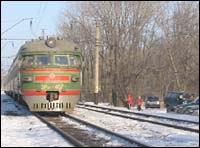
Vladivostok is the major industrial, transport,
scientific and cultural centre and the biggest ocean
port of Russia on the Pacific coast. As much as
almost 47% of its population are somehow involved
in industry, transport, and communication. The main
industries are engineering and fishing.
Fish-processing factories produce delicacies, preserves,
semi-finished and finished fish products, which
are so popular with the locals and people across
the country. The major engineering operations are
equipment manufacturing, shipbuilding and ship repair.
Confectionery, bread baking, meat and dairy processing
factories are major components of the food industry.
House development creates demand for the reinforced
concrete and large-panel constructions that are
manufactured within the city limits. Among the most
popular products are polywood, porcelain-ceramic,
and furniture.
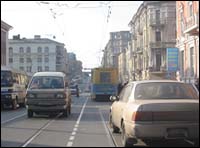
Vladivostok provides all major ways of transportation.
It is the terminus of Trans-Siberian Railroad, the
longest railroad in the world; Vladivostok, Khabarovsk
highway, and the most extended air-route of Russia.
The heart of the city is the port with its 16 piers,
4 190meters mooring line, and passenger-service
area, specialized in container and bulk cargo processing,
and shipping of cargoes to Sakhalin, Kamchatka,
Magadan, and the northern Sakha Republic. The fleet
of the Far Eastern Shipping Co. runs several international
lines.
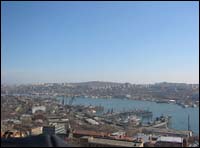
Vladivostok is prominent by its science potential.
It accommodates the Presidium (Headquarters) of
the Far Eastern Division of Russian Academy of Sciences
and 14 academic and research institutes with Far
East Geological Institute, Pacific Oceanological
Institute, Institute of Biology and Soil Sciences,
Institute of Automation and Control Processes, etc.
among them. The scientists perform complex studies
of the World Ocean and the Pacific Ore Belt, work
out recommendations on the efficient use and protection
of soils, flora, and fauna, develop new medicines,
investigate the ways of complex economic development
of Primorsky Region.
Vladivosotk is a college city. Its higher education
arsenal accounts nine universities. The most prominent
are Far Eastern State and Technical Universities,
Marine Academy named after G.I. Nevelskoy, Management
and Economics Academy, etc. They prepare captains
for merchant vessels, physicians, schoolteachers,
engineers, researchers, navy officers, and businessmen.
Specialized trade schools include shipbuilding,
meteorological, power engineering, medical, music,
pedagogic colleges, and a bunch of lyceums.
The status of major seaport in the Russian Far East
predestined for Vladivostok the role of a cultural
center. Construction of the Trans-Siberian Railroad
added a lot to the progress of social and cultural
activity in the city and in the region at large.
Vladivosok has Chamber and Drama Theatres, Puppet
Show, Philharmonic Society, Circus, and Picture
Galleries. The Russian Geographic Society established
its branch in Vladivostok about a century ago. Multiple
museums functioning here have collected precious
historical items and heritage exhibits, the most
abundant and interesting collections are displayed
by the Museum of Regional Lore, History and Economics
named after V.K. Arsenyev, Pacific Fleet History
Museum, Museum of Fishery and Oceanography, and
Aquarium. The Marine Preserve in the vicinity of
Vladivostok is a Natural Museum of Local Sea-Life.
Streets and buildings of the city include over 200
memorials. Combination of old and modern architecture
reflects the history of Vladivosotok In the downtown
the buildings of XIX-early XX centuries stand next
to the ones from 1970s. Several old buildings are
protected as a woodwork architecture heritage of
late XIX century. Under intensive town planning
the city preserves its historical appearance, individual
buildings, and even streets are protected as historical
memorial.
Health resorts and sanatoriums in the vicinity of
Vladivostok provide qualified medical and recreation
services not only for locals, but also for the people
from all
over Russia. The area accommodates the best in Siberia
and the Russian Far East health facilities, multiple
vacation houses and tourist centers, and the children's
recreation camp "Ocean" that functions
all-the-year-round.
 NAKHODKA.
NAKHODKA.
|
"Nakhodka, the city of mariners,
fishermen, construction workers and longshoremen"
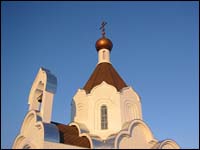
Nakhodka is the second biggest city in Primorsky
Kraï, situated in the southeastern part of
the maritime territory, on the shore of the Sea
of Japan.The climate in Nakhodka is quite the same
as in Vladivostok; cold in winter, mild in summer
and influenced by the proximity of the sea.
Nowadays, about 190,000 persons are living on the
territory of the city.
|
 History:
History: |
In 1859, the first map of the Nakhodka Bay was drawn.
One year later was discovered what is called now
the Wrangel Bay. Today on the shore of this bay,
is situated the Vostochny Port, the largest Russian
port in the Pacific. At the beginning of the 20th
century, Russian settlers founded the village of
Americanka, followed by others. In the late 1930's,
were transferred to Nakhodka the first NKVD (the
Soviet police corrective-labour agency). Ten years
later, the district received the name of Nakhodka
workers district and the first large commercial
seaport started its operations in 1947.
May the 18th, 1950 is considered to be the date
of birth of the actual city as it received its present
name.
Since Vladivostok was a closed city after the Second
World War, Nakhodka became the only Pacific port
which handled foreign ships and also acted as the
eastern terminal of the Trans-Siberian Railroad,
for tourists in transit to Japan.
 Administrative structure of the city.
Administrative structure of the city. |
The structure of the local administration bodies
is divided in three different components. First
the Mayor's Office. The Mayor is the chief executive
elected by the population for a period of 4 years.
The Mayor is responsible for the day-to-day affairs
of the city.

Secondly, the City Legislative Assembly named also
Duma, composed of 11 members. The Duma is the representative
body of the local population and their members are
elected for a period of 4 years. It oversees the
local economic legislation and has budgetary powers.
Finally, the Municipal Government with both executive,
administrative powers and prerogatives. It is directed
by the Mayor of the city and includes the following
departments: health care, education, culture, trade...
 Foreign Economic Links.
Foreign Economic Links. |
Up to 700 ships with the flags of 70 states docked
at the commercial port, and the town was quick to
develop international links. Currently it is twinned
with towns in Japan, the USA, China and South Korea.
The town has four all-year ports, a commercial,
fishing and oil port, as well as Russia's most modern,
Vostochny Port, which has coal, container and timber
terminals. Almost all the cargo traveling to Asia
by rail is unloaded here. In 1990 the town gained
the status of a free economic zone, although projects
to build a Russian and American industrial park
and a Russian-Korean industrial complex remain on
the drawing board.
Most of the investments have been made in the development
of transport and communications sectors.
 Small guide of the City:
Small guide of the City: |
Hotels.
Yuan Dun, Nakhodkinsky Prospekt 51
(4236) 62-04-25
Syuan Yuan Gonkong, Malinovsky Street 32,
(4236) 64-09-84
Piramid -Otel, Vladivostokskaya Street 2,
(42366) 5-77-60
Rent, Pogranichnaya St 27,
(4236) 64-48-88,
Dialog-invit, Sovetskaya St,
(4236) 64-07-61
Gorizont, Leningradskaya 12,
(4236) 62-36-07
Restaurants.
Restaurant "Zaliv Amerika"
 USSERISK
USSERISK |
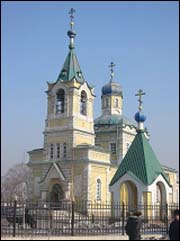
Lying 112 km from Vladivostok on the railway line
to Khabarovsk, Ussurisk was founded in 1866. The
first settlers were peasants from Astrakhan and
Voronezh regions in southwestern Russia. Thirty-two
years later, the village Nikolskoye became a town,
and changed its name to Nikolsk-Ussurisky, and began
to grow rapidly. In the Soviet period it was named
Voroshilov until 1957, when it received its present
name of Ussurisk.
The small pleasant town has retained a historic
center with stone mansions jostling small wooden
cottages. Its chief industries are Ussurisky Balzam,
a factory making liqueurs and vodka, and Primorskaya
Soya, a soya producer.
The town has many Chinese and Korean immigrants,
with a Korean cultural centre and a large Chinese
market.
Ussurisk has two theatres, and a local history museum,
as well as several attractive old churches.
 Hotels
Hotels |
Hotel Ussurisk tel. 42341 291-42 or 3-16-94 Nekrasova
Street, 64
Oazis Hotel complex
San Yuan , corner of Chicherin and Lenin Streets,
42341 2 46 59
Yubileinaya, Polushkina Street 118, (42341) 4-71-60,
6-31-25
|

